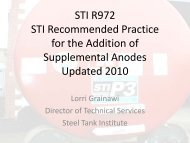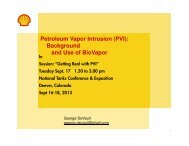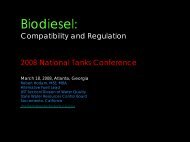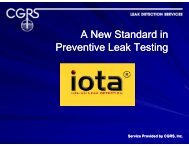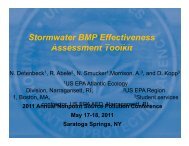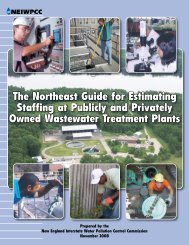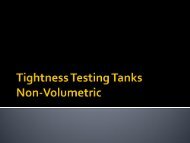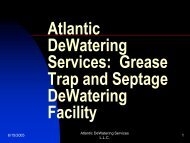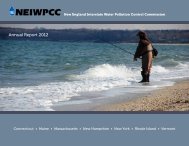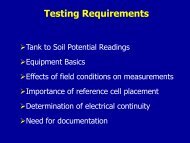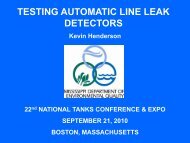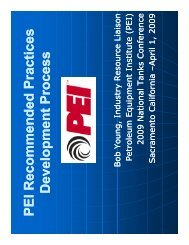BERT'S OIL Service INC. - NEIWPCC
BERT'S OIL Service INC. - NEIWPCC
BERT'S OIL Service INC. - NEIWPCC
You also want an ePaper? Increase the reach of your titles
YUMPU automatically turns print PDFs into web optimized ePapers that Google loves.
Overview –Security Plan Requirements1.Research & Special ProgramsAdministration (RSPA), HM-232.2. Must be in place by September 25,2003.3. To address security risks.4. Establish a performance standard.5.To reduce and mitigate risk.6. Focus on potential threats, personnel,unauthorized access, & en routesecurity.
Security Plan TrainingRequirementsAll Bert’s employees that transport orhandle petroleum products:1. Must be trained in security awareness.2. Must receive In-Depth security training.3. Must receive this training annually.4. New employees are trained in 90 days.To comply with DOT security regulationsHM-232.
IF LOADING YOU MUST (CONT.)9. FILL SLOWLY AT START UNTIL SPOUT ISSUBMERGED.10. BE ALERT FOR ABNORMAL CONDITIONS.11. REMOVE SPOUT BEFORE MOVING TRUCK.12. REMOVE GROUNDING CABLE.13. SECURE HATCHES AND VALVES.14. CHECK TRUCK FOR LEAKS.YOU ARE RESPONSIBLE FOR SAFE LOADING
VulnerabilityHazardous materials in transportationare vulnerable to sabotage.In the wrong hands they pose a securitythreat.Drivers must be alert to theirsurrounding, and changes at or in routeto delivery points, that could pose athreat.
Suspicious activity orbreach in security.All employees are responsible toreport suspicious activity or abreach in security to the Dispatcherand the Safety Directorimmediately.
SUSPICIOUS Activities (CONT.)Terrorists will go to many lengths toaccomplish their goals. They will often:1. Take pictures of the facility, equipmentand vehicles.2. Observe your daily activities and makenotes of all routine operations.
SUSPICIOUS Activities (Cont.)3. They will often approach you and try toget information about your operation,deliveries, and specific equipment thatyou have.4. They may elect to enter your facility toremove vital paper work, such as maps,security plans, trip tickets, deliverytickets, uniforms etc.5. They might steal equipment or productto use in making a bomb.
SecurityAt no time should anyone that is not anemployee of the company be allowedaccess to the tank storage areas orareas where the vehicles are parked.Any visitor, inspector or other personsthat might have need to access theproperty shall do so after signing in atthe office and rendering properidentification.
Security (CONT.)All employees will be issued a photoIdentification Badge and are required towear it at all times.
Security (CONT.)Drivers must always follow theirdesignated route.Any deviation from the delivery routemust be reported to and approved bydispatch.
Security (CONT.)Any time a HAZMAT driver leaves thecargo tank motor vehicle (e.g. breaktime, down time, or end of shift, etc.) thekeys must be removed from the ignition,windows fully rolled up and the doorslocked.
Security (CONT.)All drivers must notify dispatchimmediately if you are delayed alongyour route due to:1. Heavy traffic.2. Long lines at the terminal.3. You have stopped to render authorizedassistance.4. Mechanical problems, break down etc.
Security (CONT.)Whenever a HAZMAT driver parks acargo tank motor vehicle for any reasonother than during loading and unloadingoperations, the parking area selectedmust be well lit, safe and havereasonable visibility and security,
Security (CONT.)HAZMAT drivers may not deviate from aplanned route or delivery scheduleunless the dispatcher is notified beforethe change is made,
Security (CONT.)HAZMAT drivers are forbidden to pick uphitchhikers, allow any unauthorizedperson in the truck cab, stop formotorists in distress or pull over at therequest of any person unless instructedto do so by a law enforcement official,
Security (CONT.)During a CONDITION RED:HAZMAT drivers are required to conducta “walk around” inspection of the cargotank motor vehicle after each delivery orstop to check for unauthorized alteration,tampering or other suspicious activity,
Security (CONT.)HAZMAT drivers should be alert to anysuspicious activities that may endanger thepetroleum shipment, such as:Talkative strangers inquiring about theshipment,Roadside distractions such as disabledvehicles,Occupants of vehicles pulling along side thecargo tank motor vehicle attempting tocatch your attention or distract you.Be especially wary of vehicles with threeor more male occupants,
Security (CONT.)HAZMAT drivers should not talk tounauthorized persons about the deliveryroute, delivery schedule or ultimatedestination of any petroleum shipment,
Security (CONT.)All cargo tank motor vehicles andrelated equipment, bulk plant securitydevices and company offices wherepetroleum shipment information islocated must be locked and keys storedin a secure area when unattended or notin use,
VULNERABILITYASSESSMENT1. 49 CFR 172.802.BERT’S <strong>OIL</strong> Security Plan.2. Risk Assessment.3. Risk Reduction.
Seven Steps to Managing Risk1. Identify areas of concern.2. Assemble Information.3. Identify Risk Control Points.4. Select & prioritize options.5. Take action.6. Verify implementation.7. Evaluate effectiveness.
RISK REDUCTIONTo minimize the risk of sabotage,employees are not to discuss oursecurity plan, daily operations or ourdelivery routes with any person that isnot directly connected to the company.If you are questioned by anyone withrespect to this plan, that is not directlyconnected to the company, you shouldreport this to the Safety Director.
Risk Reduction (CONT.)While en-route to delivering productif you should come upon a motoristin need of assistance, do not stop.Contact dispatch and report theincident so that the properauthorities can render assistance.
Risk Reduction (CONT.)The only time a driver should renderassistance is when it is obvious thatthere is a life or death situation.Prior to rendering assistance thedriver shall first contact thedispatcher and inform them of thesituation and your exact location.
RISK REDUCTION (CONT.)Each driver is required to perform apre-trip inspection of the vehicle. Thisinspection includes but is not limited to:1. A complete exterior examination of thevehicle. To include the under carriage.2. A complete interior inspection, includingunder seats and all compartments.3. Complete Vehicle Condition Report andturn in to dispatch.
RISK REDUCTION (CONT.)While conducting the pre-trip inspection ifyou find something attached to thevehicle, something inside of the vehicleor that the vehicle has been tamperedwith.DO NOT touch anything, do not attemptto start the vehicle. Report it immediatelyto your Safety director.
RISK REDUCTION (CONT.)After reporting your finding to the safetydirector.1. SECURE the area.2. DO NOT let anyone go near thevehicle. The security officer will notifythe proper authorities.3. DO NOT use two way radios or cellphones in the general area of thevehicle.
Risk Reduction (CONT.)When returning your vehicle at the end ofyour shift, it is the responsibility of thedriver to ensure that the vehicle isparked in its proper location.The vehicle must be fully secured byrolling up windows, locking all doors andsecuring the keys in their proper locationprior to leaving for the day. Log out fuellevel and bulk product on board.
Risk Reduction (CONT.)HAZMAT drivers and HAZMATemployees will receive periodicinformation on security precautions forpetroleum shipments,
Risk LevelsThere are three levels of risk:YELLOWORANGERED
YELLOWWhen delivering product class I or II youmust have:1. Your trip ticket.2. Wear your employee photo ID badge.3. Lock vehicle at all times.
YELLOW (cont)School bus drivers must do the following:1. Pre check of bus.2. Wear employee photo id badge.3. Keep vehicle secured at all times whenit is not occupied.
YELLOW (cont)The following procedures are in effectwhile at bulk storage plants:1. Use key card access if available.2. Wear your employee photo ID badge.3. Be vigilant of any unusual activity.
YELLOW (cont)All outside visitors and vendors tocompany facilities where petroleum bulkplants or cargo tank vehicles are presentmust first obtain a visitor’s pass beforegaining entry.
ORANGEHigh Risk delivery locations areidentified through Assessment ofHazards & Risk and include:1. Bath Iron Works.2. NAS Brunswick.3. Power Plants.4. Water treatment Plants & Reservoirs.5. Critical Infrastructure (bridges, lawenforcement and government buildings).
ORANGE (cont.)While delivering product the followingmust be adhered to:ALL CONDITION YELLOW proceduresAND:1. Provide advance notification of deliveryto High Risk locations.
ORANGE (cont.)While receiving Class I product thefollowing must be adhered to:ALL CONDITION YELLOW proceduresAND:1. Verify drivers ID.2. Check trip ticket.3. Notify Police if delivery is during otherthan normal operating hours.
REDWhile delivering product the following mustbe adhered to:ALL CONDITION ORANGE procedures.AND:1. Provide advance notification of deliveryto High Risk locations.2. During daylight (except for emergency).
RED (cont.)While receiving Class I product thefollowing must be adhered to:ALL CONDITION ORANGE proceduresAND:1. Station employee guard (if police need).1. Verify drivers ID.2. Check trip ticket.3. Notify Police if delivery is during otherthan normal operating hours.
RED (cont.)School bus drivers must adhere to:ALL CONDITION ORANGE proceduresAND:1. CONDITION RED procedures from:SAU Administration.Law Enforcement.In an emergency, schools will be closedand busses may be required by police.
RED (cont.)While at bulk storage plants following mustbe adhered to:ALL CONDITION ORANGE proceduresAND:1. LOCK gates to disable key card access.2. NO visitors in plant (except emergency).3.Area lighting on overnight (canopy, etc.).
RED (cont.)At the end of the day cargo tank motorvehicles are not to be preloaded withpetroleum product intended for sale. Thevehicle must be locked and parked in awell lit, secure area.
CONCLUSIONIf there is any uncertainty regarding thewritten security plan, the security riskassessment or any other securityrelated matter, it is the duty of allHAZMAT drivers and HAZMATemployees to seek clarification from thecompany’s designated security contact.
CONCLUSION (Cont.)It can happen-it already did.Remember that on 9/11 there wereterrorists RIGHT HERE in Maine andthey flew into the World Trade Center.You are responsible to yourcommunity to take this Security Planseriously.
Security TrainingTHE END



